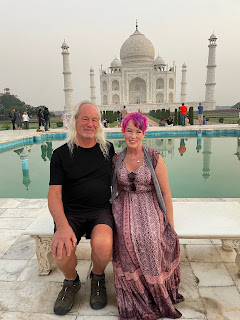On our recent trip to India and
Nepal, J was constantly getting bitten, whereas I didn’t get bitten once. I’m
not sure how Marmite protects, but I do know taking regular Vitamin B complex supplements
can have the same effect. However, I’m not recommending it as a complete
protection. When I went to Uganda a few years ago, a country where malaria is
endemic, I naturally took additional precautions. This included taking the antimalarial
medication, Doxycycline (every day a week before, during my stay and for four
weeks after returning to the UK) and using a DEET-based spray on exposed skin. The
spray had a smell that I grew to loathe by day three of my trip. That said, I
didn’t come down with malaria.
Malaria is a dangerous and indiscriminate
disease. Across the world it kills more than 1 million people each year. People
become infected through mosquito bites. And it only takes one bite to become
infected. Indeed, almost 700 million people contract a mosquito-borne illness
each year. Perhaps not surprising when you know that mosquitoes outnumber
humans 160,000 to 1. They are tough little critters, who continually develop
resistance to the insecticides used and so are very difficult to get rid of as
well. Not impossible however, and it is certainly possible to eradicate malaria
given the right commitment and approach. It is what happened in China in 2021,
see here, and the Bill and Melinda Gates Foundation continue to work across the
globe in the fight to make malaria a disease of the past.
There was a malaria vaccine
developed by the pharmaceutical company GSK in 2021, but its cost was prohibitive
for worldwide usage. Certainly, in those countries where malaria is prevalent -
countries such as Uganda, Nigeria and Tanzania - the per capita health spend is
very low. In Tanzania for example it is just £12 per person per year; to put
that into perspective, in the UK it is over £4,000 per person per year. Even critical
medication like the GSK vaccine can become impossible to provide at a
population level with such low per capita spend.
So, it was great to read last
week the preprint paper in the Lancet (a paper that has yet to be peer
reviewed) of the work undertaken by a team working at the University of Oxford,
who have successfully developed a malaria vaccine (at the moment called R21). I
was amazed that anyone could write a paper that has 28 authors, but here it is. The evidence presented in the paper suggests that the vaccine can protect
children aged between three and five years old. Up to 96% of all malarial
deaths in Africa are children aged five or under. It is as effective as the GSK
vaccine, but can be made available at half the price, thus making population
wide use possible in low-income countries. The vaccine has already been
approved for use in a number of such countries.
Now, you might be thinking why is
the Prof writing about malaria when it’s not something to be found in the UK. Well,
you would be wrong. The last known case in the UK occurred in 1957. It was a consequence
of troops returning home in 1915 from fighting in the Balkans during the First
World War. They had been garrisoned in camps on the Isle of Sheppey, in Kent.
Malaria was endemic in the Balkans, so many of the returning troops were
infected. The Isle of Sheppey was an area where mosquitoes lived in abundance. The
unintended consequence was a mass outbreak of malaria that took until 1921 to control.
As the world climate changes, and
it feels like we are experiencing rapid changes to the climate, it is easy to
envisage a much greater risk of diseases spreading in ways previously unseen.
The world is heating up and disease in one part of the world might, in the
future, spread much more easily. And we are already seeing this happen. In 2010
the Culex modestus mosquito was detected in large numbers in the Thames
estuary. In 2016 the Aedes albopictus mosquito was first detected in England. Neither
of these are native mosquitos, and both are responsible for life-threatening
tick-borne diseases elsewhere in the world. It is Halloween time and if you
want a real fright, have a look at the latest report (2021) published by the UK
Health Security Agency, and just think about the Isle of Sheppey story… …I for
one am glad that we now have the R21 vaccine in our national medicine cabinet.





